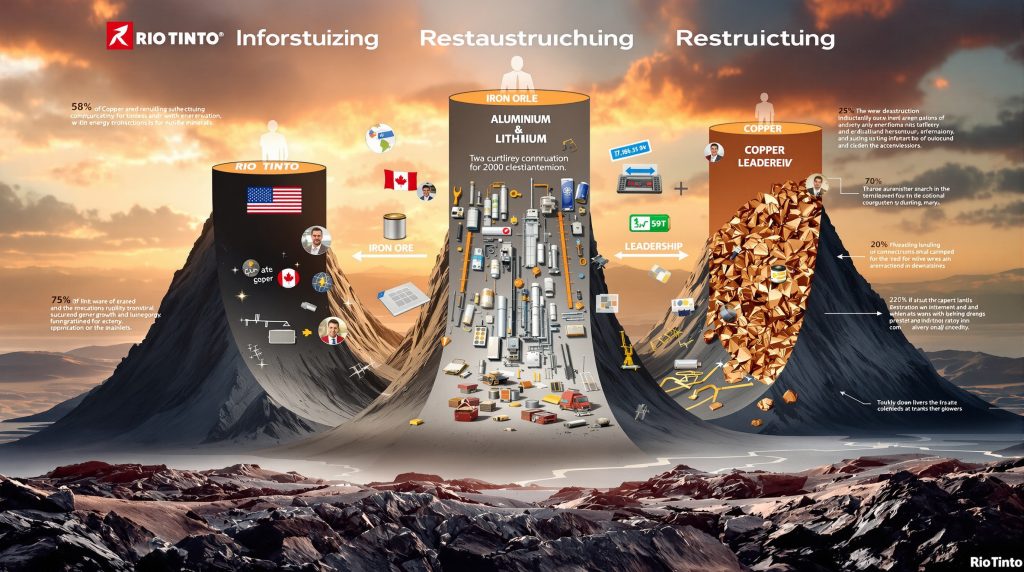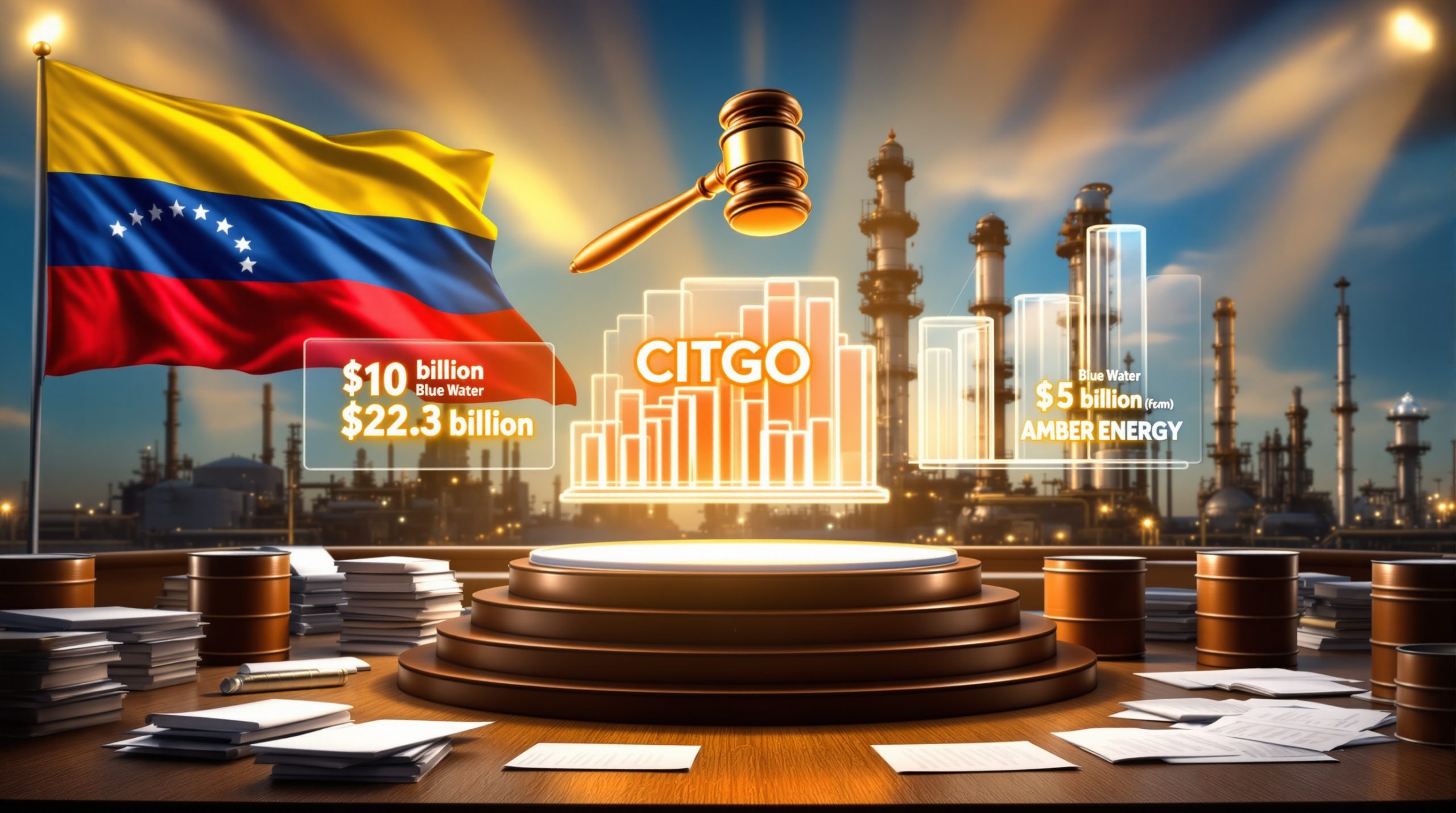Rio Tinto's Strategic Restructuring: Transforming Operations for Future Growth
Rio Tinto is undertaking a comprehensive transformation of its business structure, consolidating operations into three strategic product groups to enhance efficiency, streamline decision-making, and strengthen its global position. This significant organizational shift represents a fundamental change in how one of the world's largest mining companies manages its assets and addresses market challenges.
How Is Rio Tinto Reshaping Its Business Model?
The mining giant has implemented a simplified operating model that consolidates its operations into three core product groups: Iron Ore, Aluminium & Lithium, and Copper. This strategic restructuring aims to create a more agile organization capable of responding swiftly to market changes while maintaining operational excellence.
The Three-Pillar Structure
The new structure organizes Rio Tinto's assets into clearly defined categories:
- Iron Ore operations are now unified globally, bringing together assets across multiple continents
- Aluminium & Lithium are combined as processing-intensive commodities with similar technical requirements
- Copper maintains its position as a standalone strategic focus due to its critical role in the energy transition
- Non-core assets have been moved to a commercial portfolio for strategic review and potential divestment
The restructuring takes immediate effect, signaling the company's commitment to rapid implementation and value creation. This represents a fundamental shift from the previous geographic-based divisions to a commodity-focused global integration strategy that aligns with emerging industry evolution trends.
Key Leadership Transitions
Several significant leadership changes accompany the restructuring:
- Simon Trott has been appointed as the new Chief Executive, bringing extensive experience in mining operations
- Matthew Holcz now leads the integrated Iron Ore division, overseeing assets across multiple continents
- Jérôme Pécresse heads the combined Aluminium & Lithium group, leveraging synergies between these processing-intensive commodities
- Katie Jackson continues to lead the Copper division, maintaining continuity in this strategic segment
- The company also announced the departure of long-serving executive Sinead Kaufman after a 28-year career that began when she joined as a geologist in the UK in 1997
"A simplified business structure, grounded in our fundamental commitment to safety and with sharper focus on the most compelling opportunities we have, will enable us to deliver new standards of operational excellence and value creation," said Simon Trott, Rio Tinto's new Chief Executive.
Why Is Rio Tinto Restructuring Now?
The timing of Rio Tinto's restructuring aligns with several market and operational factors that make this strategic shift particularly relevant in the current environment.
Market Positioning for Energy Transition
Rio Tinto's restructuring reflects a strategic response to the growing importance of materials critical to the global energy transition:
- The consolidation of lithium assets with aluminium operations positions the company to better serve battery and lightweight materials markets
- The enhanced focus on copper acknowledges its essential role in electricity generation, transmission, and storage
- This positioning aligns with projected increases in demand for battery materials as electrification accelerates globally
- The streamlined structure enables more efficient capital allocation toward energy transition opportunities
The restructuring acknowledges that both aluminium and lithium markets face increased scrutiny regarding sustainability and ethical sourcing. By integrating these operations, Rio Tinto aims to offer greater transparency and control throughout these critical supply chains.
Operational Excellence Objectives
The new structure facilitates several operational improvements:
- Implementation of proven safety systems across a broader asset base, standardizing best practices
- Technology standardization across similar operational types, reducing duplication and enhancing efficiency
- Knowledge transfer between mature and developing assets, leveraging institutional experience
- Improved project delivery timelines and cost management through centralized expertise
Productivity initiatives such as the Safe Production System will be deployed more broadly across the integrated business units, building on their positive impact within existing operations.
Financial Performance Drivers
Financial considerations form a core rationale for the restructuring:
- The new structure creates a sharper focus on highest-return opportunities within the portfolio
- Capital can be deployed more efficiently across integrated operations with similar characteristics
- Talent concentration in strategic growth areas maximizes human resource impact
- Enhanced supply chain resilience for core commodities improves cost control and market responsiveness
"Our focus now is on unlocking further shareholder value, putting both our capital and talent where it will deliver the greatest returns," explained Simon Trott, highlighting the financial motivation behind the changes.
What Changes Are Coming to Rio Tinto's Iron Ore Business?
The transformation of Rio Tinto's iron ore operations represents one of the most significant aspects of the restructuring, creating a truly global iron ore business under unified leadership.
Global Integration Strategy
The iron ore restructuring brings together geographically dispersed operations:
- Western Australian operations are now merged with the Iron Ore Company of Canada under single leadership
- The Simandou project in Guinea will be incorporated into this unified structure upon completion
- Matthew Holcz leads this consolidated division as Chief Executive Iron Ore
- Standardized operational practices will be implemented across these diverse geographies
This integration links mature sites with an emerging major project, forming a broader global business with enhanced capabilities and market presence.
Operational Synergies
The consolidated structure enables significant operational benefits:
- Cross-implementation of safety protocols between established sites and developing operations
- Technology sharing between mature mines and newer developments reduces duplication
- Expertise transfer from experienced operations to growth assets accelerates development
- Supply chain optimization across multiple continents enhances efficiency and resilience
By bringing these operations together, Rio Tinto aims to share best practices on safety, roll out proven technologies, and transfer operational expertise across its entire iron ore portfolio.
Market Positioning Benefits
The unified iron ore division creates strategic market advantages:
- Coordinated production planning across global assets optimizes market response
- Enhanced ability to adjust to regional market shifts through diversified operations
- Improved customer delivery reliability through integrated supply chain management
- Stronger negotiating position in global markets due to coordinated approach
Iron ore remains central to global steel production and infrastructure development. By streamlining leadership and operations, Rio Tinto intends to ensure its supply chain becomes more resilient, consistent, and efficient in serving these critical industries.
How Will Aluminium and Lithium Integration Work?
The combination of Rio Tinto's aluminium and lithium businesses represents an innovative approach to managing processing-intensive commodities under unified leadership.
Strategic Rationale
Several key factors drove the decision to combine these operations:
- Both aluminium and lithium production involve complex, energy-intensive processing requirements
- The combined business is organized into three operational divisions: Atlantic Aluminium, Pacific Aluminium, and Lithium
- Jérôme Pécresse brings specialized expertise to lead this integrated group
- The structure leverages shared downstream processing knowledge across both commodity types
This grouping of processing-intensive commodities allows Rio Tinto to apply learnings across operations with similar technical challenges and market dynamics.
Operational Advantages
The integration creates several operational benefits:
- Implementation of the Safe Production System across all processing facilities standardizes safety practices
- Technical expertise can be shared between aluminium and lithium processing operations
- A unified approach to energy management and sustainability addresses common challenges
- Coordinated capital investment across the processing portfolio optimizes resource allocation
Productivity initiatives proven successful in aluminium operations can now be deployed more broadly across the lithium business, accelerating operational improvements.
Market Alignment
The combined unit aligns with evolving market dynamics:
- Both commodities are positioned to serve growing battery materials demand, particularly in the automotive sector
- The integration enhances supply chain transparency for sustainability-focused customers
- A coordinated approach to energy-intensive processing challenges improves cost management
- The structure facilitates a more cohesive response to evolving ESG requirements across both commodities
This consolidation reflects the changing nature of global demand, with lithium playing an increasingly important role in battery production while aluminium remains vital in transportation, packaging, and construction.
What's Happening with Rio Tinto's Copper Strategy?
Rio Tinto's decision to maintain copper as a standalone product group underscores its strategic importance to the company's future.
Production Focus Areas
The copper strategy encompasses several key operational assets:
- Continued development of Oyu Tolgoi operations in Mongolia, a flagship copper project
- Stabilization efforts at Kennecott operations in the United States to optimize existing production
- Advancement of the Resolution project in Arizona, a significant future copper source
- Development of the Nuevo Cobre project in Chile, expanding the company's copper footprint
These diverse assets provide Rio Tinto with a balanced portfolio of operating mines and development projects across multiple jurisdictions.
Strategic Importance
Copper's standalone status reflects several strategic considerations:
- The division remains under Katie Jackson's leadership, providing continuity and focused expertise
- Copper is recognized as an essential metal for global energy transition applications
- The structure enables concentrated focus on improving project delivery and operational consistency
- The company maintains its commitment to expanding copper production capacity to meet growing demand
By preserving copper as a separate product group, Rio Tinto acknowledges its unique copper market insights and growth potential in the context of global electrification.
Market Positioning
The copper strategy positions Rio Tinto to capitalize on market trends:
- The structure prepares the company for anticipated increases in copper demand driven by renewable energy
- It maintains strategic focus on both established copper regions and emerging opportunities
- The approach balances brownfield expansion with greenfield development to manage risk
- Enhanced supply chain reliability ensures consistent delivery to customers in critical sectors
Copper demand is projected to increase significantly due to its essential role in electricity generation, transmission, and storage technologies, making it a cornerstone of Rio Tinto's future growth strategy.
What Leadership Changes Accompany the Restructuring?
The restructuring brings significant leadership transitions that will shape Rio Tinto's direction for years to come.
Executive Transitions
Several key leadership changes accompany the new operating model:
- Simon Trott has assumed the role of Chief Executive, bringing fresh perspective to the company's top position
- Sinead Kaufman will depart in October 2025 after a distinguished 28-year career with Rio Tinto
- The Chief Executive Australia role previously held by Kellie Parker has been eliminated
- A new Head of Australia position has been created with a focused mandate on stakeholder relations
These changes represent a significant evolution in Rio Tinto's leadership structure, aligning executive responsibilities with the new operational model.
Career Highlights of Departing Leaders
The restructuring marks the end of several notable executive careers at Rio Tinto:
- Sinead Kaufman progressed from her start as a geologist in the UK to executive leadership
- She played a pivotal role in Rio Tinto's strategic exit from coal operations, a significant portfolio shift
- Kaufman contributed substantially to establishing the company's lithium business
- Former CEO Jakob Stausholm described his nearly five-year tenure as "one of the most extraordinary chapters of my professional life"
Stausholm noted that his handover to Simon Trott involved extensive stakeholder engagement, including meetings with three heads of state: US President Donald Trump, Argentina's President Milei, and Guinea's President Doumbouya.
Leadership Continuity
Despite the changes, Rio Tinto has implemented measures to ensure continuity:
- A structured handover process between outgoing and incoming executives maintains operational stability
- Engagement with key stakeholders during the transition period preserves important relationships
- Executive meetings with government leaders across multiple countries reinforce commitment to host nations
- The company maintains its strategic direction during the leadership change, focusing on long-term value creation
This balanced approach to leadership transition aims to preserve institutional knowledge while enabling fresh perspectives on the company's future direction.
What Does This Mean for Rio Tinto's Future Strategy?
The restructuring provides clear indications of Rio Tinto's strategic priorities and future direction.
Production Growth Outlook
The restructuring supports Rio Tinto's production ambitions:
- The company remains on track to deliver its mid-term production growth targets across key commodities
- The enhanced focus on highest-return opportunities will guide future investment decisions
- More efficient capital allocation across the simplified portfolio will accelerate priority projects
- Strategic positioning for energy transition materials aligns production with future demand growth
"We have delivered resilient results this year, remain on track to deliver strong mid-term production growth, and continue to make progress against our objectives," noted Simon Trott, highlighting the company's positive outlook.
Operational Excellence Focus
The simplified structure enables several operational improvements:
- Streamlined decision-making processes allow faster responses to market changes
- The fundamental commitment to safety remains a cornerstone across all operations
- New standards for operational performance and value creation will drive continuous improvement
- Enhanced project delivery capabilities will accelerate the development of new assets
The restructuring creates clear lines of accountability for operational performance, with leadership directly responsible for specific commodity groups rather than geographic regions.
Stakeholder Engagement
Rio Tinto maintains its commitment to strong stakeholder relationships:
- Government and community relationships remain a priority, particularly in host countries
- The new Head of Australia role focuses specifically on external partnerships and stakeholder engagement
- High-level engagement with heads of state across multiple countries reinforces commitment to host nations
- The company continues to balance shareholder interests with community and environmental responsibilities
This multi-faceted approach to stakeholder engagement recognizes the complex operating environment facing global mining companies and the importance of maintaining social license to operate.
How Will This Restructuring Impact Rio Tinto's Supply Chains?
The restructuring has significant implications for Rio Tinto's global supply chains, potentially enhancing resilience and efficiency.
Supply Chain Integration Benefits
The consolidated structure enables improved supply chain management:
- Coordinated planning across global operations optimizes resource allocation and logistics
- Standardized processes for similar commodity types reduce complexity and duplication
- Diversified sourcing across multiple geographies enhances resilience against regional disruptions
- Improved inventory management and logistics coordination reduces costs and delivery times
By integrating supply chains within commodity groups rather than geographic regions, Rio Tinto aims to create more consistent and efficient delivery systems for customers worldwide.
Technology Implementation
The restructuring facilitates technology improvements across the supply chain:
- Digital solutions can be deployed consistently across similar operations, reducing system fragmentation
- Operations with similar challenges can share learning and best practices more effectively
- Proven operational technologies can be adopted more rapidly across the integrated business units
- Enhanced data-driven operations provide deeper insights into supply chain performance
These technology improvements support Rio Tinto's goal of creating more transparent, reliable, and efficient supply chains for its key commodities.
Sustainability Considerations
The restructured supply chains address growing sustainability concerns:
- A unified approach to ESG requirements across product groups ensures consistent standards
- The integrated structure enables coordinated responses to increasing supply chain transparency demands
- Standardized reporting on environmental and social performance improves disclosure quality
- Enhanced traceability for critical minerals and materials meets customer and regulatory expectations
With both aluminium and lithium markets facing increased scrutiny over sustainability and ethical sourcing, Rio Tinto's integrated approach aims to provide greater transparency and control throughout these supply chains.
What Other Assets Are Affected by the Restructuring?
Beyond the three core product groups, several other Rio Tinto assets are impacted by the restructuring.
Portfolio Review Process
The restructuring includes a strategic review of certain assets:
- Borates and Iron & Titanium businesses have been moved to the Chief Commercial Officer's portfolio
- These operations will undergo a comprehensive strategic review to determine their long-term fit
- Normal operations continue without disruption during the assessment period
- The review may lead to future strategic decisions regarding these assets' place in the portfolio
This process establishes a clear distinction between Rio Tinto's core strategic assets and those that may eventually be repositioned within the portfolio.
Non-Core Asset Management
The approach to non-core assets reflects several strategic considerations:
- Clear separation between strategic and non-strategic assets improves management focus
- Operational excellence remains a priority even for assets under strategic review
- The process may identify divestment or partnership opportunities for certain operations
- Each asset will be assessed for its strategic fit within the simplified structure
Despite their placement outside the three core product groups, these operations continue without disruption, maintaining production targets and safety standards during the review period.
Business Continuity
Rio Tinto has implemented measures to ensure business continuity during the transition:
- Operational disruption is minimized during the organizational changes
- Production targets remain unchanged across all assets regardless of their strategic positioning
- Safety focus continues as the top priority across the entire portfolio
- Clear communication with employees and stakeholders maintains confidence during the transition
This balanced approach to portfolio management allows Rio Tinto to optimize its asset base while maintaining operational stability and stakeholder confidence through industry consolidation strategies.
FAQs About Rio Tinto's Restructuring
What is the timeline for Rio Tinto's restructuring implementation?
The new operating model takes immediate effect, with leadership changes already announced and implemented. The integration of operations will occur progressively, with some aspects dependent on project completion timelines. For example, the incorporation of the Simandou project into the Iron Ore group will take place once construction is complete. The full benefits of the restructuring are expected to materialize over the coming months as the new organizational structure matures.
How will this restructuring affect Rio Tinto's workforce?
While executive leadership changes have been announced, Rio Tinto has not detailed specific workforce impacts at operational levels. The focus appears to be on organizational structure rather than significant headcount reduction, with emphasis on deploying talent to areas of highest strategic value. The company continues to prioritize safety and operational excellence, suggesting that core operational roles will remain stable during the transition.
What does this mean for Rio Tinto's sustainability commitments?
The restructuring reinforces Rio Tinto's focus on sustainability by enabling more consistent implementation of environmental and social practices across similar operations. The integration of processing-intensive businesses facilitates a more coordinated approach to energy management and environmental performance. Additionally, the enhanced supply chain transparency resulting from the restructuring supports Rio Tinto's ability to meet increasing customer and regulatory demands for responsibly sourced materials.
How will this affect Rio Tinto's position in critical minerals markets?
The restructuring strengthens Rio Tinto's focus on energy transition materials, particularly through the standalone Copper group and the integration of Lithium with Aluminium. This positions the company to respond more effectively to growing demand for battery materials and electrification metals. The simplified structure enables faster decision-making and more efficient capital allocation toward these strategic growth areas, potentially accelerating Rio Tinto's expansion in critical minerals markets.
What impact will this have on Rio Tinto's shareholders?
Rio Tinto has explicitly stated that the restructuring aims to unlock further shareholder value by focusing capital and talent on the highest-return opportunities. The simplified structure is designed to improve operational accountability and enhance returns on investment. According to Mining.com, by streamlining decision-making and optimizing resource allocation, the restructuring should enable more efficient capital deployment and potentially higher returns for shareholders over the medium to long term.
Ready to Identify the Next Major Mineral Discovery?
Gain real-time alerts on significant ASX mineral discoveries with Discovery Alert's proprietary Discovery IQ model, turning complex data into actionable investment insights. Visit the dedicated discoveries page to understand why historic discoveries can generate substantial returns, and begin your 30-day free trial to position yourself ahead of the market.




